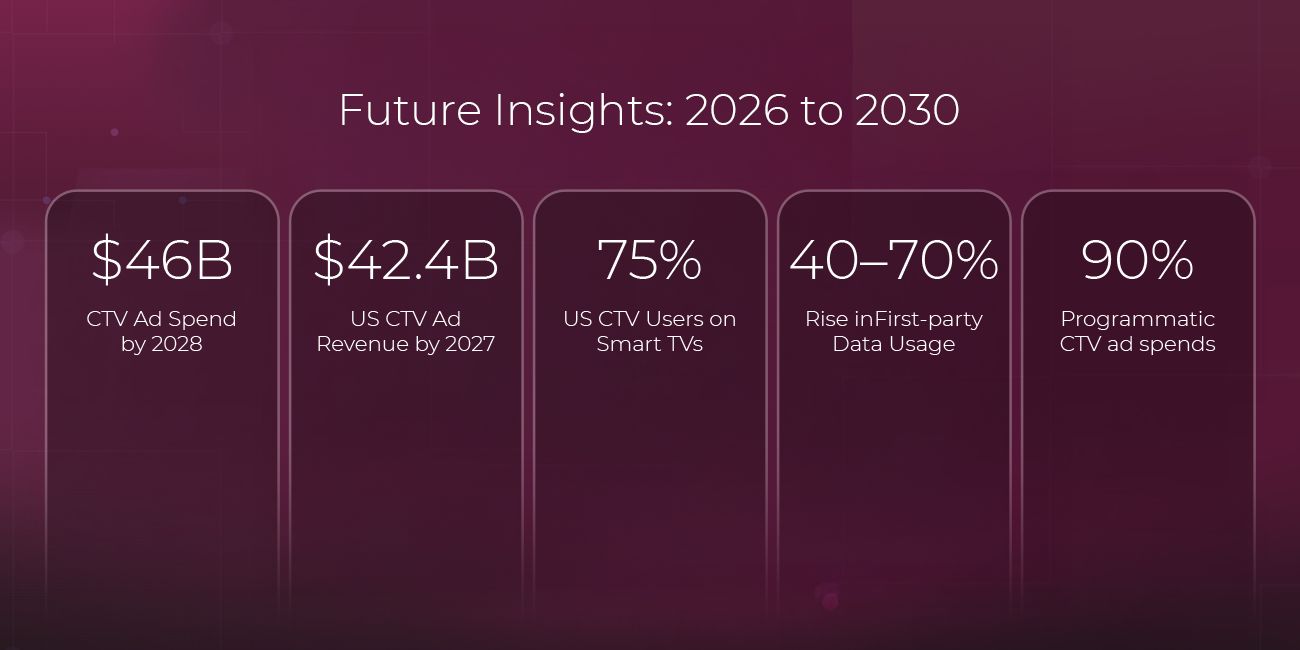
Connected TV advertising has moved beyond brand awareness campaigns. In October 2025, performance marketers are using CTV to drive measurable outcomes—from website visits to actual sales. The channel now combines the visual impact of television with the tracking precision of digital platforms.
CTV ad spending reached $33.35 billion in the United States in 2025, and this growth tells an important story. More than 56% of marketers globally plan to increase their OTT/CTV budgets in 2025, with 68% considering CTV essential in their media plans.
The shift is clear: streaming captured 44.8% of total TV viewership in May 2025, surpassing broadcast and cable combined for the first time.

Why Performance Marketers Are Moving to CTV
The Scale Is Real
117 million U.S. households now own at least one internet-connected TV device, with 90% of U.S. households using CTV at least once per month. This isn’t a niche channel anymore.
U.S. adults spend an average of 131.5 minutes per day watching CTV content in 2025. That’s more than two hours of focused, lean-back viewing time. Compare this to the fragmented attention users give to mobile or desktop screens.
Programmatic Makes It Accessible
Here’s where things get interesting for performance marketers: over 90% of CTV ad spend is now transacted programmatically. You don’t need massive budgets or traditional TV relationships anymore. Demand-side platforms let you buy inventory across multiple streaming services with audience-level targeting.
70% of CTV ad transactions are conducted programmatically by 2025. This brings real-time bidding, automated optimization, and performance tracking that traditional TV buyers could never dream of.
Completion Rates Beat Everything Else
CTV ads deliver completion rates between 90-98%, with 15-second ads averaging 94.5% completion. These aren’t skippable pre-rolls. Viewers actually watch your entire message.
Performance marketers care about one thing: did the audience see your ad? CTV delivers this at scale. The format creates a focused viewing environment where ads get seen and remembered.
From Awareness to Action: The Performance Shift
Real Attribution Is Here
The game changed when CTV platforms started tracking cross-device conversions. When someone watches your CTV ad, visits your website on their phone, and makes a purchase, modern attribution models can connect those dots.
According to Innovid’s 2025 CTV Insights report, CTV accounted for just 38% of impressions but drove over 63% of attributable conversions across their data set. This shows efficiency that performance marketers understand.
CTV-exposed households convert 45% higher than others, proving the channel’s impact on purchase behavior. The attribution technology uses household graphs to link TV exposure with actions on other devices.
ROAS That Makes Sense
Numbers matter in performance marketing. CTV delivers an average return of nearly $6 for every dollar spent, almost three times higher than linear TV.
Real brands are seeing real results. Metro Vein Centers started with a cost per website visitor of $14.86 in their first CTV campaign, then reduced it by 85% through optimization and retargeting. Kane Footwear delivered 250% higher ROAS than their goal.
These aren’t awareness metrics. These are performance numbers that show up in your dashboard and affect your bottom line.
More Than Half Focus on Performance Goals
The industry has noticed this shift. Over half of CTV advertisers now prioritize sales, store visits, and leads over awareness. 65% of marketers classify CTV as a performance channel, with 52% using it to drive metrics like web visits and revenue.
This represents a fundamental change in how the channel gets used. CTV isn’t just for Super Bowl spots anymore.
Building Your CTV Performance Strategy
Start With Clear Goals
Define what success looks like before you launch. Are you driving website traffic? App downloads? Product purchases? Store visits? Each goal needs different creative approaches and measurement frameworks.
Track metrics that matter:
- Reach and frequency for awareness campaigns
- Conversion rate and CPA for direct response
- ROAS for revenue-focused campaigns
- Incremental lift to measure true impact
CTV offers closed-loop attribution that links specific outcomes to your ad spend. Use it.
Target Like a Performance Marketer
Programmatic CTV lets you use the same audience data from your mobile or display campaigns. Upload first-party CRM data, retarget website visitors, or build lookalike audiences based on your best customers.
Available targeting options include:
- Demographic targeting: Age, gender, income, education
- Geographic targeting: DMA, zip code, radius targeting
- Behavioral targeting: Purchase intent, lifestyle, interests
- Contextual targeting: Genre, content type, daypart
- Retargeting: Previous website visitors or customers
- ABM targeting: Firmographic and persona-level data for B2B
The precision rivals any digital channel while keeping the impact of the big screen.
Optimize Creative for Performance
Your CTV creative needs to work harder than a brand spot. Hook attention in the first three seconds. Put your brand and core benefit up front. Keep offers or QR codes visible for at least 20 seconds.
Make sound-off work with captions, but reward sound-on viewing with payoffs. Produce multiple variants around different angles: problem/solution, social proof, heavy offers. Test everything.
Every call-to-action must be mobile-optimized. “Scan to buy,” “Use code TV25,” “Start free trial”—these should land on fast, UTM-tracked, mobile-first pages.
Choose the Right Platform
Platforms like Unwire from Xapads Media bring programmatic CTV capabilities designed for performance marketers. You need a partner that understands both the TV ecosystem and performance marketing principles.
Look for platforms that offer:
- Real-time bidding and optimization
- Cross-device attribution and tracking
- Transparent reporting on performance metrics
- Integration with your existing marketing stack
- Household-level frequency management

The Future: 2026 to 2030
Growth Will Continue
CTV ad spending will reach $46.89 billion by 2028, surpassing traditional TV advertising for the first time. By 2027, U.S. CTV ad revenues will hit $42.4 billion, representing growth that outpaces every other digital advertising channel.
The math is simple: audiences are moving to streaming, and advertising dollars follow audiences. By 2028, over 75% of U.S. CTV users will access content via smart TV, making the experience even more seamless.
Retail Media Meets CTV
Watch this space. Retail media CTV ad sales will more than double from $4.99 billion in 2025 to $10.28 billion by 2028. By 2029, one in five U.S. CTV ad dollars will go to retail media platforms.
Amazon is leading this convergence, connecting its retail data with Prime Video and Fire TV inventory. This creates targeting capabilities that link shopping behavior directly to CTV ad exposure. For performance marketers, this means even better measurement and optimization.
Interactive and Shoppable Ads
Television advertising is becoming two-way. QR codes in ads now see scan rates as high as 70% when linked to familiar retailers. Voice-activated spots let viewers request information instantly.
Shoppable TV takes this further. Viewers can buy products directly from their screens, with formats like Walmart’s shoppable ads generating 3x higher sales. Features include dynamic product overlays, AR previews, and one-click purchases.
By 2027, expect more interactive formats that blur the line between advertising and commerce. Performance marketers who test these formats early will have a significant advantage.
AI-Driven Optimization
AI is making CTV campaigns smarter in real-time. Machine learning algorithms analyze millions of data points to optimize bid prices, creative selection, and audience targeting continuously.
Over 90% of CTV display ad spend happens programmatically, and AI powers most of these decisions. Future platforms will predict which creative will perform best for specific audiences before the campaign even launches.
Dynamic creative optimization will become standard. The same base ad will automatically adjust messaging, offers, and calls-to-action based on who’s watching and their likelihood to convert.
Privacy-First Measurement
As the industry moves away from third-party cookies, CTV offers a path forward. First-party data usage has increased 40-70% since cookie deprecation announcements. CTV platforms work with clean rooms and privacy-safe identity resolution to measure campaigns without compromising user privacy.
Expect more partnerships between streaming platforms and data providers. Disney launched BridgeID, NBCUniversal integrated with Google’s PAIR framework, and more are coming. These identity solutions enable targeting and measurement while respecting user privacy.
Getting Started With CTV Performance Marketing
Test With Purpose
Start small but start smart. Commit enough budget to reach at least 250,000-1,000,000 households over 4-6 weeks. This gives you statistical power in your measurement.
Run A/B tests on creative, offers, and targeting. Use incrementality testing to measure true lift. Compare performance across different streaming platforms and content genres.
Integrate With Your Funnel
CTV works best when integrated with your full marketing funnel. Use search, paid social, and branded keyword campaigns during and after CTV flights to capture multi-device demand.
Sync with retail media and e-commerce partners to retarget in-market audiences. Someone who saw your CTV ad becomes a warmer lead for your lower-funnel tactics.
Partner With Experts
The CTV landscape is complex. Multiple platforms, varied inventory sources, different measurement standards. You need a partner who understands both the technology and the strategy.
Xapads Media’s Unwire platform brings 15 years of digital advertising expertise to CTV. The team understands performance marketing principles and applies them to the streaming environment.
Conclusion
Connected TV has evolved from a brand awareness channel into a full-funnel performance marketing platform. The combination of massive reach, precise targeting, high completion rates, and measurable outcomes makes it essential for modern performance marketers.
The data proves it. CTV delivers 23% higher ROI than traditional TV, with 90-98% completion rates and attribution capabilities that connect TV exposure to actual business results.
As we move toward 2030, CTV will become even more sophisticated. Interactive formats, AI-driven optimization, and deeper integration with retail media will create opportunities that don’t exist today. Performance marketers who build CTV expertise now will lead the next wave of digital advertising.
The shift from reach to ROAS is complete. CTV isn’t the future of performance marketing—it’s the present.








